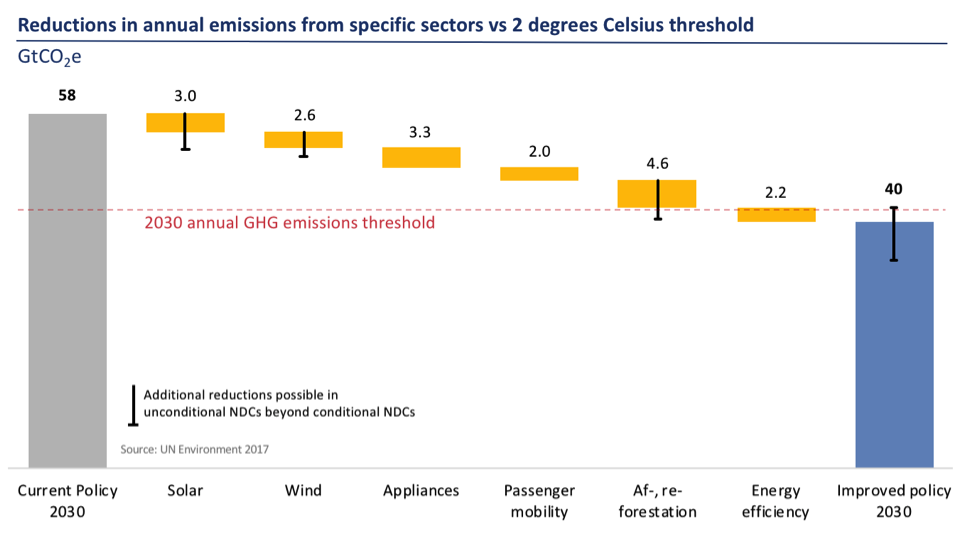
The Policy Consensus for Faster, Cleaner Economic Growth
Originally posted at weforum.org here.
Coordinated public-sector support once kick-started the technologies, business practices, and markets needed for a clean, prosperous, and secure low-carbon energy future.
Over time, the increasing profitability of clean energy activity has come to drive exponential growth in global annual investment—amounting to more than $333 billion in 2017—and local jobs to support the deployment of products and services. Households, businesses, and governments are now increasingly seeking these new energy solutions due to the real economic value they can provide.
But the energy transition is still not moving fast enough. And therefore, the ball is back in the policymakers’ court to accelerate the shift to the clean energy solutions of the future. Countries looking to tap into these solutions’ proven economic and environmental advantages face the new challenge of how to employ the right mix of policies to drive the transition locally, faster, and at lowest cost. As countries like China, India, and Mexico demonstrate, the motivation is not just to avoid the costs of global climate change, but increasingly also to capture their share of the transition’s economic opportunity for domestic voters and taxpayers—estimated to exceed $1 trillion per year worldwide.
Consensus Policies for an Economical Transition
To simplify policymakers’ task, the World Economic Forum’s Global Future Council on Energy reviewed the existing policy recommendations from leading think tanks, industry groups, and research institutes. It emerged that these sources were in consensus on six policies.
- Integrated policy frameworks: Traditionally segmented energy sectors will in the future need to be deeply integrated, highly electrified energy systems. As a result, governments should frame the long-term direction for the energy sector as a whole and involve key stakeholders at each stage. The result should provide a clear vision for society at large, a firm direction for emerging technologies, and a solid incentive for commercial innovation, while also ensuring investor certainty.
- Carbon pricing: At national and/or subnational levels, pricing carbon through a broad tax or cap-and-trade allowance system will help markets over time to find the lowest-cost ways to reduce emissions by providing a single, strong, and stable price signal. Sub-state, provincial alignment has proven effective in preventing cross-border “leakages”; the same should be facilitated at regional and global levels.
- Smart subsidies: Governments should look first to eliminate inefficient and regressive fossil fuel subsidies, which far outweigh those for clean technologies. Taxpayer-funded subsidies for the energy technologies of the future need careful targeting and should be responsibly allocated through market-based mechanisms, in-kind public-private partnerships, and transparent public-planning processes.
- Supportive innovation: Governments can remedy historically lackluster energy research and development (R&D) funding through in-kind funding programs and coordinating platforms. “Governments participating in Mission Innovation have pledged to double their clean energy R&D budgets, leading the way in boosting investment in much needed breakthrough technologies and applications,” says Minister Leonardo Beltrán Rodríguez, the undersecretary for planning and energy transition of the Government of Mexico. Governments can also use public tenders to leverage downstream private-sector innovation in manufacturing, supply chain, and delivery models.
- Energy efficiency: The least expensive energy is energy that is not used. Across all major energy sectors, from power generation and distribution to industry, transport, and buildings, immense opportunities exist for efficiency. Besides incenting direct investment in efficiency—once estimated to offer 100 percent return on $500 billion in the U.S. alone—the most effective policies institute clear mandates and standards for appliance, building, and vehicle efficiency.
- Electricity market design: The attributes of increasingly cost-effective electricity generation, storage, and use technologies, as well as the rise of IT-enabled rapid interactivity between supply- and demand-side resources, pose new challenges for electricity markets. “As an independent market operator, we believe that optimal approaches are needed for an efficient system that allows the greatest practical level of competition and innovation to ultimately deliver the best results for consumers,” said Audrey Zibelman, managing director and chief executive officer of the Australian Energy Market Operator.
Underlying each of these recommendations is evidence of how policies supporting the transition fare: first, that businesses will mobilize quickly and efficiently in response to smart, supportive, and stable policies designed for scale. In developed markets, this entails replacing dirty and inefficient assets with clean, resilient, and low-cost ones. In developing countries, those policies can support rapid economic growth that avoids the traps of past industrial models by using new energy technologies and market designs of the future.
Second, where the winds of proven technologies and market designs are at your back, as in the energy transition, policy changes that can quickly result in economic growth and commercial competitiveness are less controversial.
Enabling Policy to Close the Emissions Gap to 2 C°
These consensus policies, in addition to others just shy of unanimity, amount to a toolbox for policymakers. They will need it: UN Environment’s 2017 Emissions Gap Report notes that “missing the 2020 options of revising the [nationally determined contributions] would make closing the 2030 emissions gap practically impossible.”
The good news: the policy solutions that have broad consensus can in fact frame and unleash the market activity necessary to reduce annual emissions by 2030 by more than double what is needed to maintain a pathway consistent with 2 degrees, as illustrated below.
These estimates are remarkable for showing that existing technologies and business models, coupled with proven policies from leading country contexts, can bring the world in line with the 2 C° goal through 2030.
Clear, consistent, and detailed national and subnational policies—beyond goals and commitments—can help bring these solutions to scale. Already, global markets have reduced average wind and solar prices by 47 percent and 72 percent, respectively, over the past eight years. What could we expect if policies opened the gates to not only global but also local component manufacturing, supply chains, and delivery models?
Policy to Unlock and Sustain the Transition
The few ceilings that do exist on the rapid growth of these solutions are due not to natural resources or lack of ingenuity, but to a shortage of policy imagination: forward-looking policy can structure market incentives to efficiently continue their growth.
For example, the rise of high-penetration wind and solar without storage or demand flexibility can cause traditional wholesale power markets’ pricing mechanisms to fail during peak generation hours. Exemplary policy solutions for this challenge and others are illustrated below.
Policy for Growing Domestic Economies—and De-risking the Global Glide Path
The success of policies such as these, validated by expert consensus, should leave international leaders and regulators with little cause for hesitation. These policies can tap market forces to increase local income, make energy clean and more cost-effective, improve self-sufficiency, and strengthen energy security. At the same time, they can create a collective glide path to a lower-risk, low-carbon future.
The trade-off is simple: act now with long-term, integrated policies to smooth that path, or necessitate sharp and sudden regulatory shifts in 10 to 15 years that pose the same threat to economic growth as the climate disaster they hope to address.
“Significant investment from the private sector will continue to be required to support the energy transition,” says Teresa O’Flynn, managing director at BlackRock investment management corporation. “Clean energy policy initiatives will be more successful if they acknowledge the needs of private capital and build the appropriate environment to encourage investment, which includes developing a stable, consistent, transparent long-term policy and regulatory environment.”
The WEF Global Future Council on Energy suggests that countries apply this policy toolbox to their own unique contexts, considering both challenges and opportunities it might create. They may also speed the pace of engagement and learning between their contiguous and regional neighbors, as a cooperative approach can speed domestic progress faster than a go-it-alone attitude.
As a result, countries can arrive at this year’s Facilitative Dialogues and COP26 in 2020 confident in their ability to take near-term climate mitigation action to speed economic growth—rather than threaten it.
Image courtesy of iStock.

